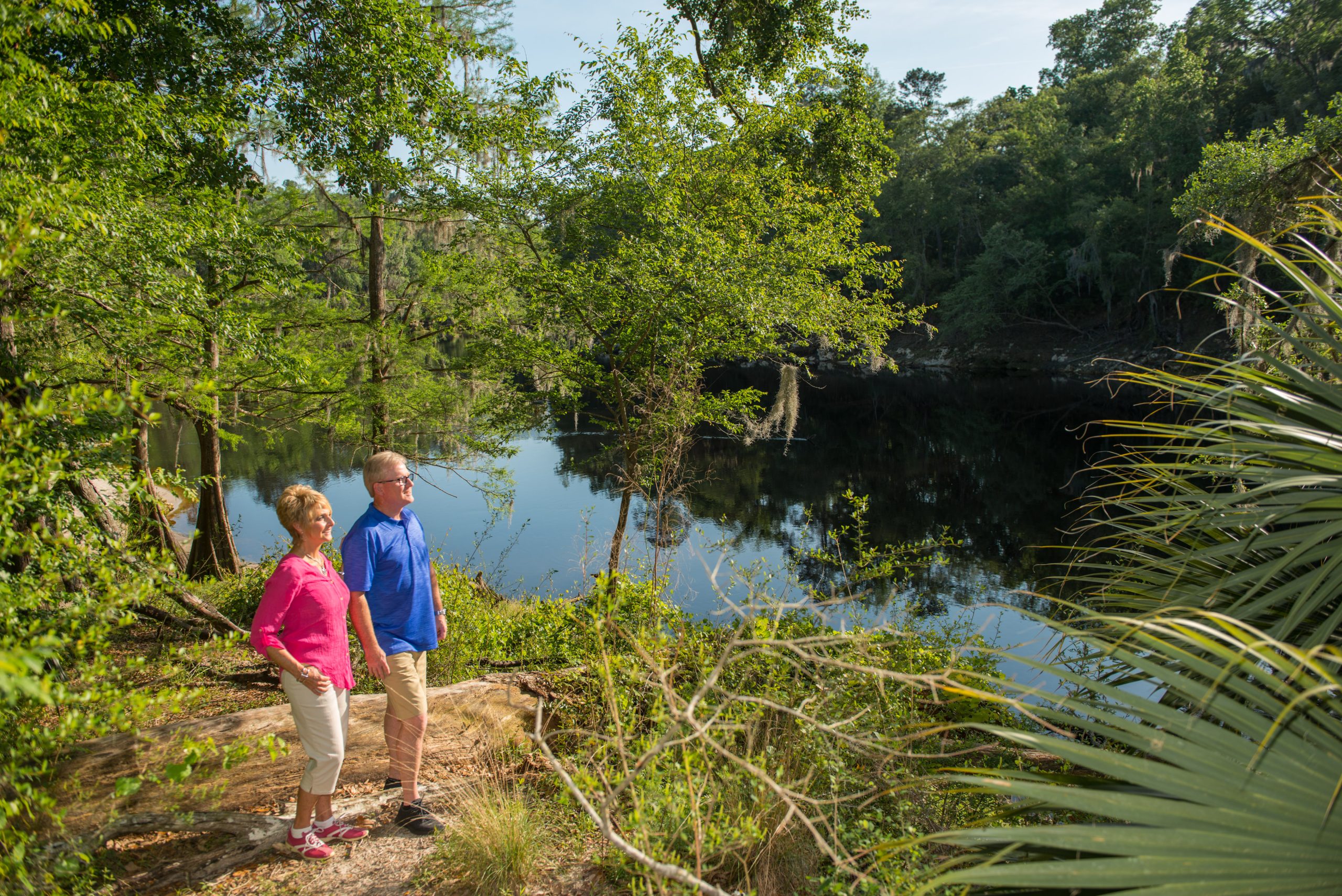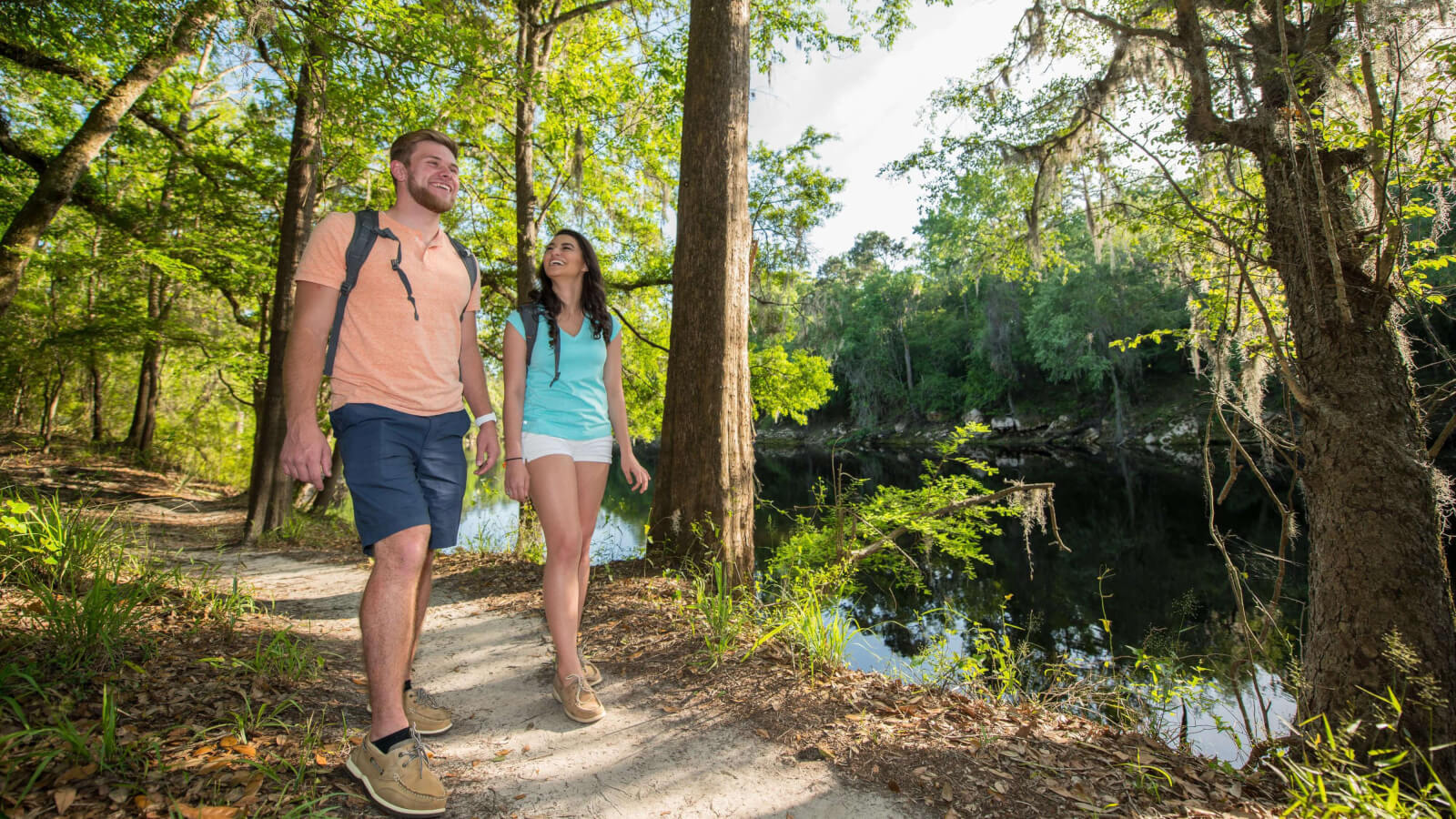
Suwannee River State Park History
Early Settlements & The History Of Suwannee River State Park
Changes in travel modes, the location of natural resources, and a variety of other events have shifted the population centers of Suwannee County over the years. As a result, many once-thriving communities no longer exist or are a shadow of their former selves. Such is the case with the once-flourishing town of Columbus, now the Suwannee River State Park.
Columbus was one of the earliest chartered American communities in Suwannee County; in 1833, the Florida Legislature authorized Paul “M’Cormic” (McCormick) to establish a ferry at the confluence of the Suwannee and Withlacoochee Rivers for five years. Six years later, on February 8, 1839, David Platt was authorized to build a ferry or toll bridge at the same location. The population quickly mushroomed, as there were enough people in the locale for a post office named Columbus to be established there on February 17, 1842. A stagecoach road eventually joined Columbus on the western boundary with Suwannee (Lower Mineral) Springs and beyond; County Road 132 roughly follows part of this old road, and it is still more commonly known as the Stagecoach Road. A visitor to Columbus, writing in the St. Augustine News in late 1843, described the community as having two large stores (with others under construction) and other mercantile establishments that bought cotton from surrounding counties. The same visitor stated that over 3,000 bales of cotton were shipped in the fall of 1843 from Columbus, with towering piles of cotton still awaiting shipment on the riverbanks. Columbus’ population was already some 500 at that time. On March 14, 1844, the Governor submitted a request to establish a mail route from Cedar Key to Columbus, intersecting the central line from Tallahassee to Jacksonville, as it “would be of great importance to the citizens of Madison, Alachua, Columbia, and Hamilton, Florida, there being no communication by mail between those places: and whereas, as that portion of the country bordering on the Suwannee River is being settled by an enterprizing (sic) and industrious community, the products of whose industry is every year increasing.”
In recognition of the community’s growth, on the same date, March 14, 1844, the town of Columbus was incorporated with John W. C. Loud, David Platt, and George H. Smith superintending until elections could be held. The following day, Joseph B. Watts, Francis Jones, David Platt, Enoch Hall, A. Vann, and Loud & Sandler formed a company to establish a toll bridge at Columbus; their charter would be good for ten years. The following year (1845), the Florida Legislature requested that the Federal Government provide $8,000 to open a mail route to be opened from Columbus to Garey’s Ferry (now Middleburg in Clay County). The year of 1845 also saw the first known steamboat with a regular run on the Suwannee River, Orpheus, carrying the weekly mail between Cedar Key and Columbus. Repeated attempts to clear obstructions along the Suwannee River at least to Columbus met with little success, as the issue was brought up almost annually until the eve of the Civil War.
Columbus had enough population in 1847 and again in 1853 to be one of Columbia County’s election precincts (Suwannee County did not yet exist). An indication of the town’s size and commerce can be gauged by the Governor’s authorization in 1849 to reimburse Mary A. Hardee and a Mrs. Burnett the sum of $12 each for the taverns that each kept in Columbus. In January of 1855, the charter of the Columbus Bridge Company was renewed for another ten years; it was probably the name of the company created by legislative action in 1844 and originally composed of Joseph B. Watts, Francis Jones, David Platt, Enoch Hall, A. and Vann, Loud, and Sadler. By the following year, however, the Columbus Bridge Company had apparently gone out of business, because William H. Watson was authorized to operate ferries at Columbus to both Hamilton and Madison Counties for a period of ten years.
Despite the apparently unsuccessful attempts to totally clear the Suwannee River of obstructions, Columbus was still important enough during the Civil War to have the only completed railroad bridge across the Suwannee River. The Pensacola and Georgia Railroad had completed this bridge in early 1861, just before the beginning of the war. An interesting fact about the bridge was that it was a wooden covered bridge, and after each train went through it, workers had to rush onto the bridge to put out any embers from the engine’s smokestack so that the entire bridge did not catch fire and burn down. This bridge served as the primary supply line for Confederate forces outside of Florida, and became all the more important after 1863, when the fall of Vicksburg cut off Confederate supplies from Arkansas and Texas. In 1864, Union troops were ordered to march from Jacksonville and destroy the bridge at Columbus. Brigadier General Joseph Finegan, commanding Confederate forces in the area, was concerned that the Union forces would outflank him and attack the railroad bridge on the Suwannee River, where he only had thirty men stationed. Union forces were defeated at the Battle of Olustee, east of Lake City, on February 20, 1864 by Confederate forces under Finegan. The bridge over the Suwannee River at Columbus thus remained in Confederate hands, supplying Confederate forces until the end of the Civil War. Confederate earthworks built near the bridge as a final defensive position remain visible and are part of the Suwannee River State Park.
After the end of the Civil War in 1865, George Franklin Drew moved to the Columbus area and built a sawmill near his home across the Suwannee River in Madison County; this had the effect of drawing people and businesses to the Madison County side of the River. In 1868, the Suwannee Steamboat Company was chartered with a goal of transferring freight and produce between Clay’s Landing and the town of Columbus in Suwannee County. The charter gave sole navigation rights between those two points to the Suwannee Steamboat Company, and any person or persons navigating or transporting freights or produce without permission of the Suwannee Steamboat Company would be guilty of a misdemeanor and fine between $200 and $500. The charter was approved on August 3, 1868, and was good for twenty years unless the Steamboat Company failed to perform the duties within five years. Columbus was still a large enough community in 1869 that it was one of Suwannee County’s six polling places to determine the county seat. During this time, Charles Dean ran the ferry crossing between Suwannee, Hamilton, and Madison Counties; his home overlooked the ferry and Suwannee River on the Suwannee County side.
By 1873, Columbus had dried up as markets shifted and financial depression hit the United States. The post office had been renamed Ellaville in 1872 and moved to the Madison County side of the River, but eventually returned to the Suwannee County side before shutting for good in 1943. All that remains of Columbus today are a cemetery, Confederate earthworks from the Civil War, the remains of the original ferry landing, and a few ghostly ruins. These are all found within the Suwannee River State Park, one of Florida’s first state parks.



